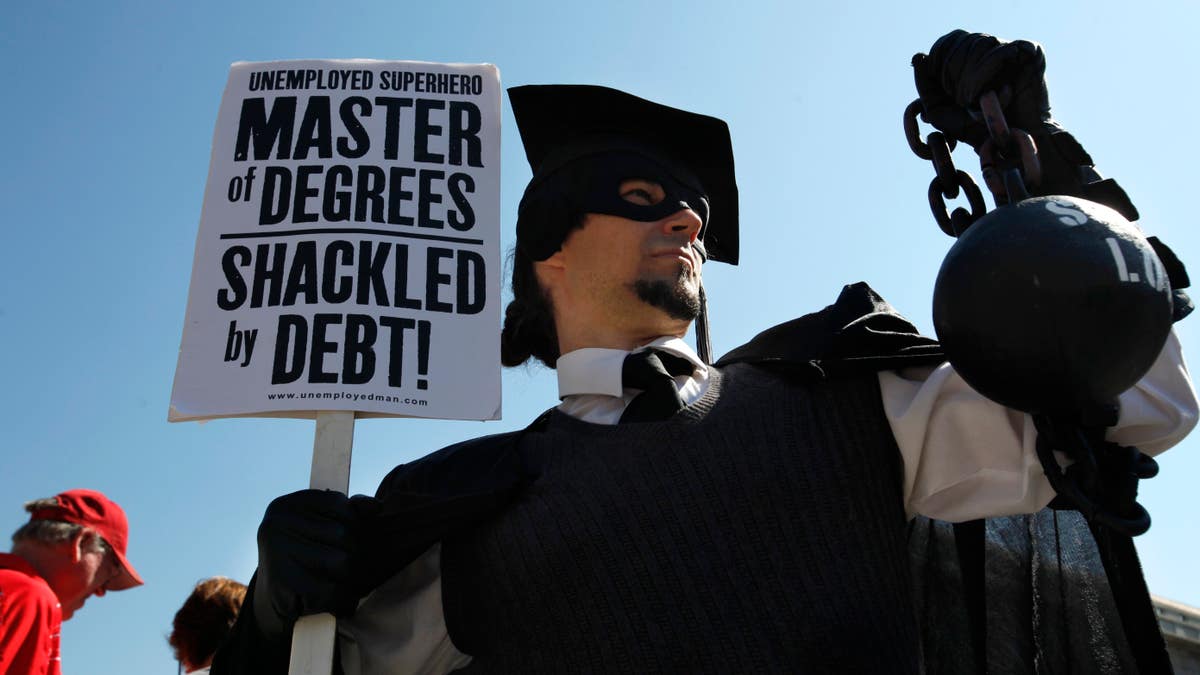
Oct. 6, 2011: Gan Golan of Los Angeles, dressed as the "Master of Degrees," holds a ball and chain representing his college loan debt during Occupy DC activities in Washington. (AP2011)
Members of the college class of 2010 who took out student loans owed on average $25,250 upon graduation, a 5 percent increase from the year before, according to a new analysis released Thursday.
The figures, compiled using college survey data by The Project on Student Debt, indicate average indebtedness increasing at about the same annual rate as in the last five years, but still give a fresh snapshot of what many advocates and experts call an alarming reliance on borrowed money to pay for college.
Roughly two-thirds of the class of 2010 borrowed for college, and they were hit especially hard because the unemployment rate for new college graduates stood at 9.1 percent the year they graduated — though that's less than half the rate for counterparts who only have a high school degree.
Another cause for concern: because of data limitations, the figures do not include students at for-profit college, where other recent data show 96 percent of graduates have loans and they borrow nearly 50 percent more than those who graduate from other four-year schools.
Debt levels do vary widely from school to school, and from region to region. The average level at individual colleges ranges from $950 to over $55,000. The report identifies 15 nonprofit institutions where students graduate with unusually high debt levels, a list that encompasses schools ranging from Regent University in Virginia to New York University to a number of art schools.
Meanwhile, students in the Northeast and Midwest generally had substantially higher debts than those in the West. New Hampshire had the highest average graduating debt of any state at $31,048, while Utah was lowest at $15,509.
These figures, on top of last week's College Board report showing a 7.3 percent increase this year in tuition prices at public four-year colleges, highlight the challenge of college affordability at a time when states have significantly cut support for higher education.
Still, the report notes the figures could have been worse. Though unlucky in the job market, the class of 2010 finished school just as a large wave of federal financial aid was washing into the system. In 2009-2010 federal spending on Pell Grants to low-income students — which do not need to be repaid and thus reduce the need to borrow — roughly doubled from two years before to over $30 billion. Over that time, the average grant increased roughly $1,000 to $3,751, according to data from last week's College Board report. However, the long-term trend is that even as the Pell Grant has risen, it's covered a lower and lower share of the actual cost of attending college.
Complaints about student debt have been front and center at a number of the Occupy Wall Street protests. Last week, President Barack Obama announced steps to protect borrowers from burdensome monthly payments, including a program to encourage loan consolidations and speeding up new options that can cap monthly payments based on a percentage of income for federal borrowers.
The report estimates at least 22 percent of the class of 2010's student debt comes in the form of private loans, which typically have higher interest rates and fewer borrower protections than loans from the federal government. Students are generally advised first to borrow the maximum from the government before turning to private loans. But previous research by The Project on Student Debt shows a majority of those who take out private loans haven't done so.
"How you borrow, not just how much you borrow, really matters," said TICAS president Lauren Asher. "If you have federal student loans, Iincome-based repayment, unemployment deferment, and other options can help you manage your debt even in these tough times,"
The Project on Student Debt is affiliated with California-based TICAS, or The Institute for College and Success, an independent nonprofit that promotes higher education access and affordability.

